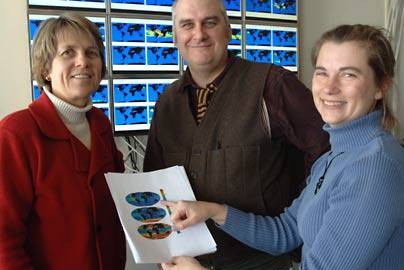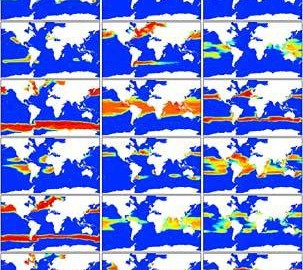Publication
Monteiro, F., M. J. Follows and S. Dutkiewicz (2010), Distribution of diverse nitrogen fixers in the global ocean, Global Biogeochemical Cycles, 24, GB3017, doi:10.1029/2009GB003731
Monteiro, F., M. J. Follows and S. Dutkiewicz (2010), Distribution of diverse nitrogen fixers in the global ocean, Global Biogeochemical Cycles, 24, GB3017, doi:10.1029/2009GB003731
Barton, A.D., S. Dutkiewicz, G. Flierl, J. Bragg, and M.J. Follows (2010), Response to Comment on “Patterns of Diversity in Marine Phytoplankton”, Science, 329 (5991), 512-d. doi:10.1126/science.1190048
Hickman, A.E., S. Dutkiewicz, R.G. Williams, and M.J. Follows (2010), Modelling the effects of chromatic adaptation on phytoplankton comunity structure in the oligotrophic ocean. Marine Ecology Progress Series, 406, 1-17, doi:10.3354/meps08588
Bragg, J., S. Dutkiewicz, O. Jahn, M. Follows, S.W. Chisholm (2010), Modeling selective pressures on picocyanobacterial nitrogen use in the global ocean, PLoS ONE, 5, e9569. doi:10.1371/journal.pone.0009569. LINK
Barton, A.D., S. Dutkiewicz, G. Flierl, J. Bragg, and M.J. Follows (2010), Patterns of Diversity in Marine Phytoplankton, Science, 327, 1509 – 1511, doi: 10.1126/science.1184961
Dutkiewicz, S., M.J. Follows and J. Bragg (2009), Modeling the coupling of ocean ecology and biogeochemistry, Global Biogeochemical Cycles, 23, GB4017, doi:10.1029/2008GB003405
Cermeno, P., S. Dutkiewicz, P.G. Falkowski, M. Follows, R.P. Harris, and O. Schofield (2008), The role of oceanic nutricline depth in regulating Earth’s carbon cycle, Proceedings of the National Academy of Sciences, 105, doi:10.1073/pnas.0811302106
Follows, M.J., S. Dutkiewicz, S. Grant and S.W. Chisholm (2007), Emergent biogeography of microbial communities in a model ocean, Science, 315, 1843-1846, doi: 10.1126/science.1138544

“Simulation condenses 10 years’ evolution into five days of computing”
Denise Brehm, Civil and Environmental Engineering
Read this story at MIT News
Scientists at MIT have created an ocean model so realistic that the virtual forests of diverse microscopic plants they “sowed” have grown in population patterns that precisely mimic their real-world counterparts.
This model of the ocean is the first to reflect the vast diversity of the invisible forests living in our oceans–tiny, single-celled green plants that dominate the ocean and produce half the oxygen we breathe on Earth. And it does so in a way that is consistent with the way real-world ecosystems evolve according to the principles of natural selection. Continue reading Ocean Model Captures Diversity of Underwater Forests

by Matthew T. Gardner for the Earth System Initiative
Read this story at MIT News
A new program to develop computational models of how marine microbes live and evolve in the global ocean has been launched with a $3.7 million gift from the Gordon and Betty Moore Foundation.
The program is important because it will help researchers understand and simulate the relationships between climate change, marine ecosystems and the ocean carbon cycle. Continue reading MIT Darwin Project will model ocean microbes